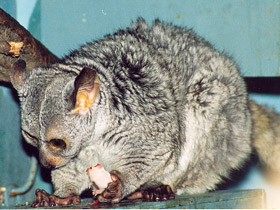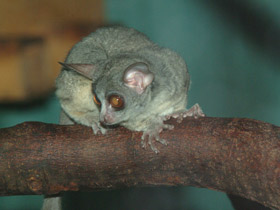Galagos, bush babies, or nagapies (the family Galagidae)
Galagos /ɡəˈleɪɡoʊz/, also known as bush babies, or nagapies (meaning "night monkeys" in Afrikaans), are small nocturnal primates native to continental, sub-Sahara Africa, and make up the family Galagidae (also sometimes called Galagonidae). They are considered a sister group of the Lorisidae.
According to some accounts, the name "bush baby" comes from either the animal's cries or its appearance. The Ghanaian name aposor is given to them because of their firm grip on branches.
Appearance and peculiarities
Galagidae are small, abundant, nocturnal animals of Africa, distributed in six genera and nineteen species. They are close relatives of the lorisidae, but the ecology of these animals is very different. Galagidae live not only in forests, but also in African savannahs and, unlike the lorisidae, they are usually on the ground. Unlike Lorisidae, Galagida are specialised jumpers, so their hind legs are longer than their front legs. They also have fluffy tails that are 1.2 to 1.8 times longer than the body, which play an important role in maintaining balance when jumping. The most expressive details of Galagidae's appearance are their huge nocturnal eyes and large webbed ears. Incidentally, these incredible ears can move independently and can be folded to prevent damage.
Nutrition
Galagidae feed mainly on insects, and can quickly grab large butterflies and beetles that pass by with their forelegs. They often find insects by their sound before they see them. Galagidae also scrape resin and extract sap from trees with their forward protruding grooved teeth. Larger species, over 350 g, have difficulty capturing enough invertebrates and must supplement their diet with fruit. Use of vertebrates as food is much rarer, although some species of Galagidae are known to capture birds and reptiles.
Social behaviour and reproduction
These animals have a fairly complex social organisation. Related females and their young live in adjacent, partially overlapping territories. The individual male plot is much larger and includes the plots of several females and their offspring. Dominant males and adult females normally exclude the presence of Galagidae of the same sex and age on their plots, but adult males may tolerate the presence of juvenile males on their plots.
Before giving birth to young, female Galagidae build a nest in which they spend their first time. At around one month of age, the young begin to travel with their mother in tow.
Approximately 20 species of Galagidae are known, all of which are found in Africa. Each species has a distinctive sound repertoire that includes 10 or more loud cries. Most are complex cries, but there are also simple, repetitive sounds. They play a role in attracting mating partners, in scaring off competitors, in alerting alarm and may reflect the animal's mood.
Taxonomic classification and phylogeny
Galagos are currently grouped into six genera. Euoticus is a basal sister taxon to all the other galagids. The 'dwarf' galagids recently grouped under the genus Galagoides have been found, based on genetic data, and supported by analysis of vocalisations and morphology, to actually consist of two clades, which are not sister taxa, in eastern and western/central Africa (separated by the rift valley). The latter are basal to all the other non-Euoticus galagids. The former group is sister to Galago and has been elevated to full genus status as Paragalago. The genera Otolemur and Sciurocheirus are also sisters.
Family Galagidae - galagos, or bushbabies:
- Genus Euoticus, needle-clawed bushbabies:
- Southern needle-clawed bushbaby, Euoticus elegantulus;
- Northern needle-clawed bushbaby, Euoticus pallidus;
- Genus Galago, lesser galagos, or lesser bushbabies:
- Galago senegalensis group;
- Somali bushbaby, Galago gallarum;
- Mohol bushbaby, Galago moholi;
- Senegal bushbaby, Galago senegalensis;
- Galago matschiei group;
- Dusky bushbaby, Galago matschiei;
- Genus Galagoides, western dwarf galagos;
- Prince Demidoff's bushbaby, Galagoides demidovii;
- Angolan dwarf galago, Galagoides kumbirensis;
- Thomas's bushbaby, Galagoides thomasi;
- Genus †Laetolia:
- †Laetolia sadimanensis;
- Genus Otolemur, greater galagos, or thick-tailed bushbabies:
- Brown greater galago, Otolemur crassicaudatus;
- Northern greater galago, Otolemur garnettii;
- Silvery greater galago, Otolemur monteiri;
- Genus Paragalago, eastern dwarf galagos:
- Paragalago zanzibaricus group;
- Kenya coast galago, Paragalago cocos;
- Grant's bushbaby, Paragalago granti;
- Zanzibar bushbaby, Paragalago zanzibaricus;
- Paragalago orinus group;
- Uluguru bushbaby, Paragalago orinus;
- Rondo bushbaby, Paragalago rondoensis;
- Genus Sciurocheirus, squirrel galagos:
- Bioko Allen's bushbaby, Sciurocheirus alleni;
- Cross River bushbaby, Sciurocheirus cameronensis;
- Gabon bushbaby, Sciurocheirus gabonensis;
- Makandé squirrel galago, Sciurocheirus makandensis.
Jumping
Galagos have remarkable jumping abilities. The highest reliably reported jump for a galago is 2.25 metres (7 ft 5 in). According to a study published by the Royal Society, given the body mass of each animal and the fact that the leg muscles amount to about 25% of this, galago's jumping muscles should perform six to nine times better than those of a frog. This is thought to be due to elastic energy storage in tendons of the lower leg, allowing far greater jumps than would otherwise be possible for an animal of their size. In mid-flight, they tuck their arms and legs close to the body; they bring them out at the last second to grab a branch. In a series of leaps, a galago can cover ten yards in mere seconds. The tail, which is longer than the length of the head and body combined, assists the legs in powering the jumps. They may also hop like a kangaroo or simply run or walk on four legs. Such strong, complicated, and coordinated movements are due to the rostral half of the posterior parietal cortex that is linked to the motor, premotor, and visuomotor areas of the frontal cortex.
Behaviour
Generally, the social structure of the galago has components of both social life and solitary life. This can be seen in their play. They swing off branches or climb high and throw things. Social play includes play fights, play grooming, and following-play. During following-play, two galagos jump sporadically and chase each other through the trees. The older galagos in a group prefer to rest alone, while younger ones are in constant contact with one another. This is observed in the Galago garnetti species. Mothers often leave infants alone for long periods and do not try to stop them from leaving. On the other hand, the offspring tries to stay close to, and initiate social interactions with the mother.
Grooming is a very important part of galago daily life. They often groom themselves before, during, and after rest. Social grooming is done more often by males in the group. Females often reject attempts by males to groom them.
Relationship with humans
The bush baby also refers to a myth that is used to scare children to stay indoors at night. Most likely arising from the baby-like cry, the unusual nature evolved into a myth about a powerful animal that can kidnap humans. It is also said that wild bush babies/galagos in Nigeria can never be found dead on plain ground. Rather, they make a nest of sticks, leaves or branches to die in. Endangerment of the species in sub-Saharan Africa has made this claim difficult to verify.





















































